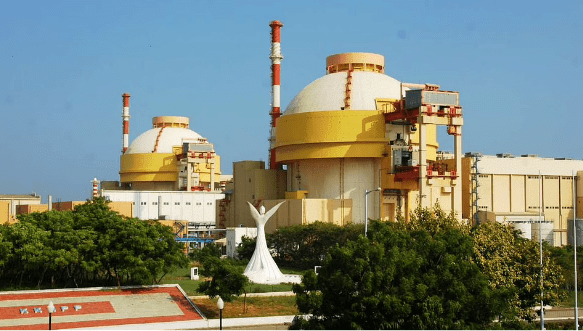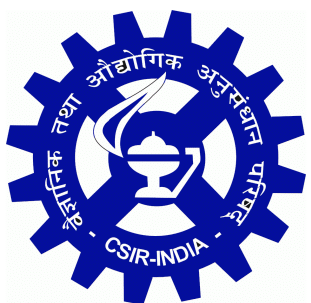Achievements of India in Science & Technology | Science & Technology for UPSC CSE PDF Download
Atomic Energy
The prime objective of India’s Nuclear energy program is the development and use of nuclear energy for peaceful purposes like power generation, applications in agriculture, medicine, industry, research and other areas.
The country today is recognised as one of the most advanced in nuclear technology including the production of source materials. The country is self reliant and has mastered the complete nuclear cycle from exploration and mining to power generation and waste management.
 Kudankulam power plant
Kudankulam power plant
Space
India decided to go to space when Indian National Committee for Space Research (INCOSPAR) was set up by the Government of India in 1962. With the visionary Dr Vikram Sarabhai at its helm, INCOSPAR set up the Thumba Equatorial Rocket Launching Station (TERLS) in
Thiruvananthapuram for upper atmospheric research.
Indian Space Research Organisation, formed in 1969, superseded the erstwhile INCOSPAR. Vikram Sarabhai, having identified the role and importance of space technology in a Nation's development, provided ISRO the necessary direction to function as an agent of development. ISRO then embarked on its mission to provide the Nation space based services and to develop the technologies to achieve the same independently.
Throughout the years, ISRO has upheld its mission of bringing space to the service of the common man, to the service of the Nation. In the process, it has become one of the six largest space agencies in the world. ISRO maintains one of the largest fleet of communication satellites (INSAT) and remote sensing (IRS) satellites, that cater to the ever growing demand for fast and reliable communication and earth observation respectively. ISRO develops and delivers application specific satellite products and tools to the Nation: broadcasts, communications, weather forecasts, disaster management tools, Geographic Information Systems, cartography, navigation, telemedicine, dedicated distance education satellites being some of them.
To achieve complete self-reliance in terms of these applications, it was essential to develop cost efficient and reliable launch systems, which took shape in the form of the Polar Satellite Launch Vehicle (PSLV). The famed PSLV went on to become a favoured carrier for satellites of various countries due to its reliability and cost efficiency, promoting unprecedented international collaboration. The Geosynchronous Satellite Launch Vehicle (GSLV) was developed keeping in mind the heavier and more demanding Geosynchronous communication satellites.
Apart from technological capability, ISRO has also contributed to science and science education in the country. Various dedicated research centres and autonomous institutions for remote sensing, astronomy and astrophysics, atmospheric sciences and space sciences in general function under the aegis of Department of Space. ISRO's own Lunar and interplanetary missions along with other scientific projects encourage and promote science education, apart from providing valuable data to the scientific community which in turn enriches science.
Future readiness is the key to maintaining an edge in technology and ISRO endeavours to optimise and enhance its technologies as the needs and ambitions of the country evolve. Thus, ISRO is moving forward with the development of heavy lift launchers, human spaceflight projects, reusable launch vehicles, semi-cryogenic engines, single and two stage to orbit (SSTO and TSTO) vehicles, development and use of composite materials for space applications etc.
 Vikram Lander of Chandrayaan-2
Vikram Lander of Chandrayaan-2
Oceanography
With coastline of more than 7600km and nearly 1250 islands, India’s Exclusive Economic Zone covers nearly 2 million sq km and continental shelf extending upto 350 nautical miles. The Department of Ocean Development was established in 1981 to ensure optimum utilisation of living resources, exploitation of non-living resources such as hydrocarbons and minerals and to harness ocean energy. The CSIR - National Institute of Oceanography has been established for study of ocean related technologies. It is also responsible for harnessing resources of the coastal belts and islands.
 CSIR-NIO made RV Sindhu Sadhana
CSIR-NIO made RV Sindhu Sadhana
Biotechnology
The remarkable march of India into the world of biosciences and technological advances began in 1986. That year, the then Prime Minister of the country, late Rajiv Gandhi accepted the vision that unless India created a separate Department for Biotechnology, within the Ministry of Science and Technology, Government of India the country would not progress to the desired extent. This was because many of our macro-economic issues of growth were subsumed within that science’s development.
That decision has made India one of the first countries to have a separate department for this stream of science and technology. However the initiation of deliberations to establish the department started much earlier In 1982, after detailed deliberations with the scientific community, and on the basis of recommendations by the then Scientific Advisory Committee to the Cabinet, a National Biotechnology Board (NBTB) was constituted by the Government to identify priority areas and evolve long term perspective for Biotechnology in India. It was also responsible for fostering programmes and strengthening indigenous capabilities in this newly emerging discipline.
The NBTB was chaired by the formidable scientist Professor MGK Menon, the then Member (Science) of India’s Planning Commission. All the Secretaries to the various departments of the government dealing with science were appointed as Members of this Board. A separate Department of Biotechnology (DBT) was finally set up in February, 1986 and the NBTB selected Dr S Ramachandran as the first Secretary of the department. The DBT constituted a ten member Scientific Advisory Committee (SAC) with heads of various scientific agencies and a seven member Standing Advisory Committee for North America SAC (0) to ensure that the Department kept abreast of global developments in the field of Biotechnology.
Dr S Ramachandran, says that Prime Minister Shri Rajiv Gandhi recognised that the pace at which biological sciences were growing globally, that “unless we leap forward, there is no way of catching up with the rest of the world”. So space was allocated to a small team to sit in the now sprawling and modern CGO Complex, at Lodhi Road, New Delhi, to set up the DBT. According to Dr Ramachndran the Department started with a modest beginning of around Rs 4 to 6 crore as its first budget.
- There were many serious challenges at the start. First, there were interdepartmental conflicts with no department willing to part with its earlier responsibilities to a new but specialised body.
- The second most important problem was the “tendency of Indian scientists to publish only in national journals” because publishing in international and solidly peer-reviewed journals took too long.
- Third, the industry could not be persuaded early to join hands as governmental procedures took too long.
- The fourth major obstacle was procuring scientific equipment and reagents and other vital necessities for lab research.
In those days in the country, not too many people were working on biosciences. The department had, therefore, to focus on
- Developing human resources
- Creation of appropriate infrastructure
- Research and development
- Creating a regulatory framework
 Covid-19 Vaccines indigenously produced during pandemic
Covid-19 Vaccines indigenously produced during pandemic
Despite the challenges, the department started to roll on almost as soon as it was formed. The first autonomous institute, the National Institute of Immunology which was set up in 1981 was brought under the wings of DBT. Soon after, it was joined by the National Facility for Animal Tissue and Cell Culture of Pune formed in 1986 which was later christened the National Centre for Cell Science. The late 1990s and early 2000 saw many other institutes like The National Institute for Plant Genome Research (NIPGR), the National Brain Research Centre (NBRC) followed, the Centre for DNA Fingerprinting & Diagnostics, Institute of Bioresources and Sustainable Development and the Institute of Life Sciences take shape. Subsequently, several other prominent institutes like Translational Health Science and Technology Institute (THISTI), Institute for Stem Cell Biology and Regenerative Medicine (INstem), National Agri-Food Biotechnology Institute (NABI) at Mohali, and National Institute of Biomedical Genomics (NIBMG) at Kalyani in West Bengal were established.
There is also renewed effort on social aspects such as health care, food and agriculture, energy and environmental security. International collaborations have become more strategic, with better reach and breadth and industry partnerships are growing. The new focus on Young India is clear from the various Grants and Funds as well as Awards, and the DBT’s commitment to revisit the funding mechanism to ensure a quicker assessment of project values and disbursements of funds for research.
CSIR
The Council of Scientific & Industrial Research (CSIR), known for its cutting edge R&D knowledge base in diverse S&T areas, is a contemporary R&D organization. CSIR has a dynamic network of 37 national laboratories, 39 outreach centres, 3 Innovation Complexes, and five units with a pan-India presence. CSIR’s R&D expertise and experience are embodied in about 3460 active scientists supported by about 4350 scientific and technical personnel as of June 2021.
CSIR covers a wide spectrum of science and technology – from oceanography, geophysics, chemicals, drugs, genomics, biotechnology and nanotechnology to mining, aeronautics, instrumentation, environmental engineering and information technology. It provides significant technological intervention in many areas concerning societal efforts, which include environment, health, drinking water, food, housing, energy, farm and non-farm sectors. Further, CSIR’s role in S&T human resource development is noteworthy.

Pioneer of India’s intellectual property movement, CSIR today is strengthening its patent portfolio to carve out global niches for the country in select technology domains. CSIR filed about 225 Indian patents and 250 foreign patents per year during 2015-20. CSIR has a patent portfolio of 1,132 unique patents in force, out of which 140 patents have been commercialized. CSIR also has 2,587 in force patents granted abroad in multiple countries. Amongst its peers in publicly funded research organizations globally, CSIR is a leader in filing and securing patents worldwide.
CSIR has pursued cutting edge science and advanced knowledge frontiers. In 2019, CSIR published 5009 papers in SCI Journals with an average impact factor per paper of 3.714.
CSIR has operationalized desired mechanisms to boost entrepreneurship, which could lead to enhanced creation and commercialization of radical and disruptive innovations, underpinning the development of new economic sectors.
CSIR has put in place CSIR@80: Vision & Strategy 2022 – New CSIR for New India. CSIR’s mission is “to build a new CSIR for a new India”, and CSIR’s vision is to “Pursue science which strives for global impact, the technology that enables innovation-driven industry and nurtures trans-disciplinary leadership thereby catalyzing inclusive economic development for the people of India”.
CSIR is ranked 37th among 1587 government institutions worldwide and is the only Indian organisation among the top 100 global government institutions, according to the Scimago Institutions Ranking World Report 2021. CSIR holds the 7th rank in Asia and leads the country at the first position.
|
146 videos|358 docs|249 tests
|
FAQs on Achievements of India in Science & Technology - Science & Technology for UPSC CSE
| 1. What are some notable achievements of India in the field of Science and Technology? |  |
| 2. How did India contribute to space exploration? |  |
| 3. What is the significance of India's achievements in the field of biotechnology? |  |
| 4. What are some notable technological advancements by India in recent years? |  |
| 5. How has India's scientific research and innovation impacted its economic growth? |  |
|
146 videos|358 docs|249 tests
|

|
Explore Courses for UPSC exam
|

|



















